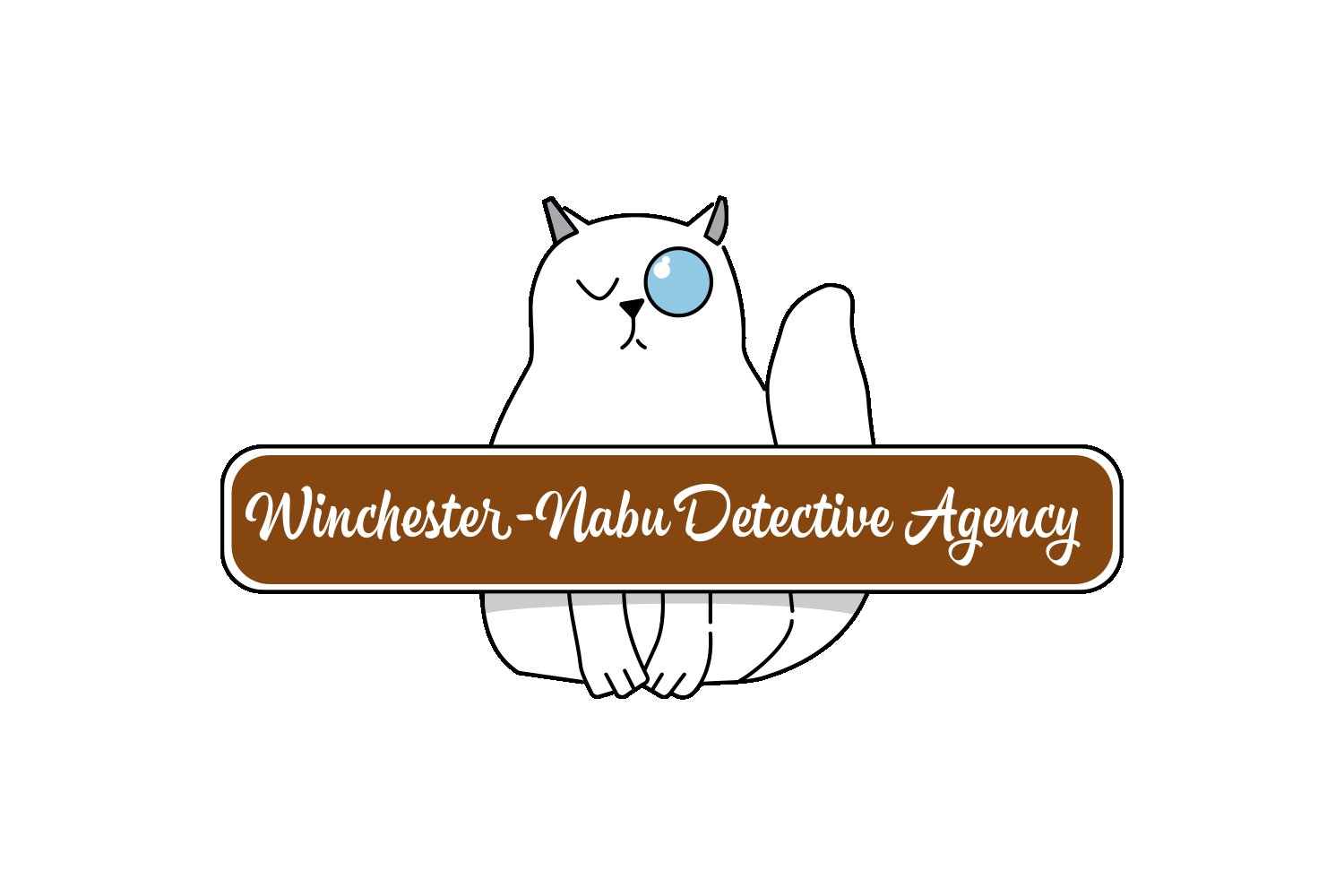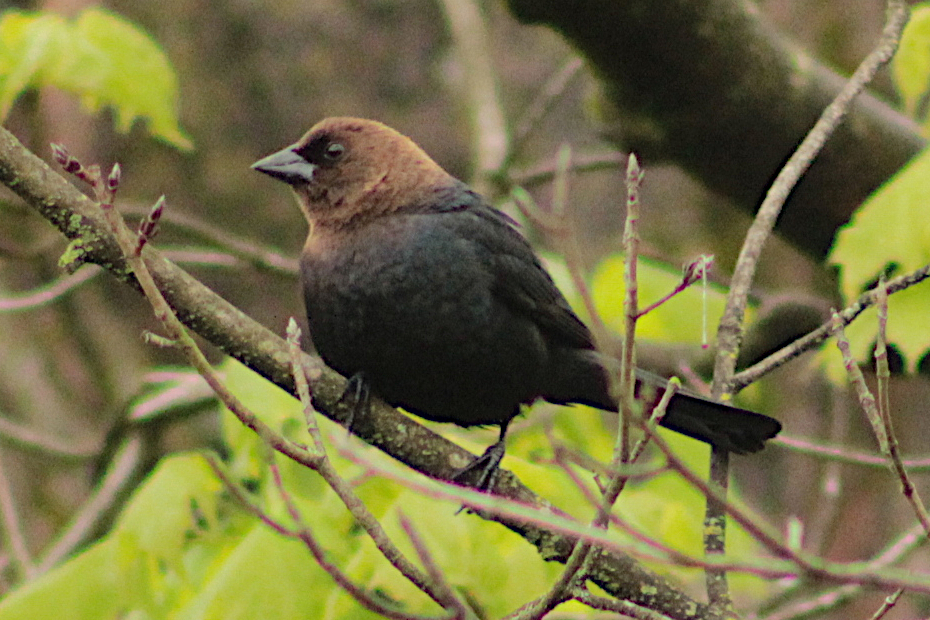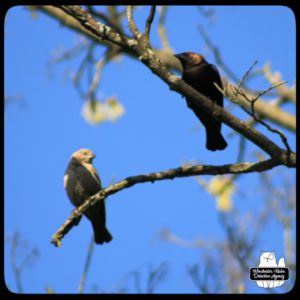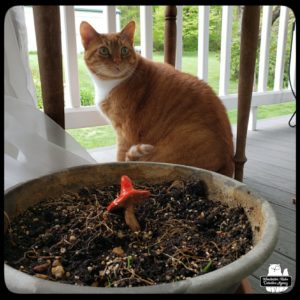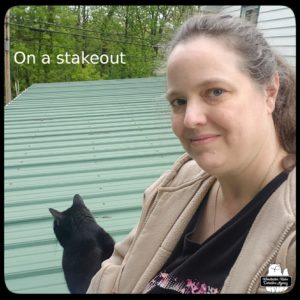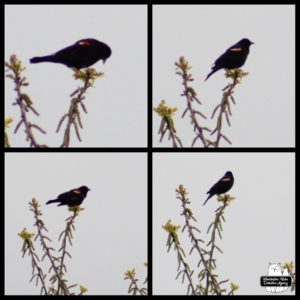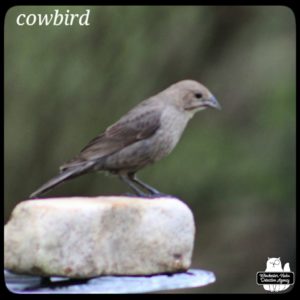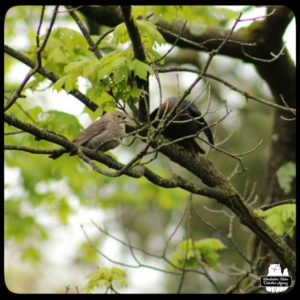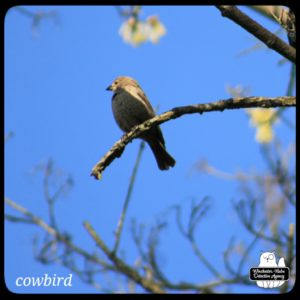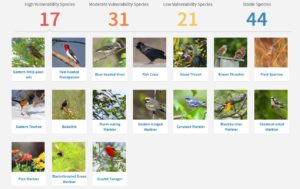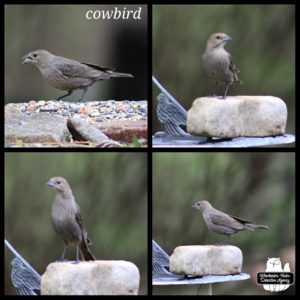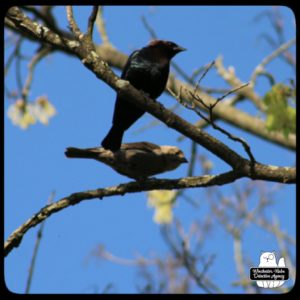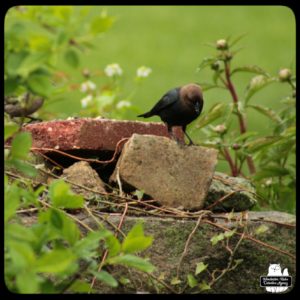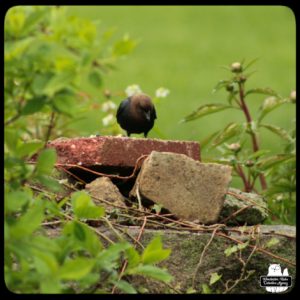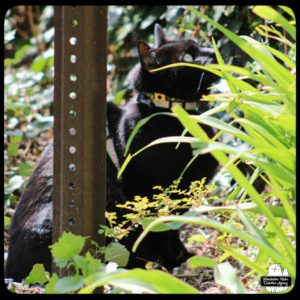This work is supported by the generous backers who adore my cat stories at Patreon.com/amberunmasked and they also get first access to what’s happening with my books and podcast.
Where We Left Off:
A Toad visited us for a couple of days and gave us a cryptic message.
Parasite:
Welcome to Year Seven of the Winchester-Nabu Detective Agency investigations! Spring has blossomed and critters are starting to socialize. Beltane came and went. Gus and I didn’t do anything in particular for the annual May Day celebration, but I saw some Instagram posts of people having a good time. There’s also the connotation of May Day—labor rights. I support the WGA writers on strike. The CEOs of entertainment networks make a fortune and it does not trickle down.
Here at the estate, the brown-headed cowbirds have been upfront and center which is new behavior for them. In previous years, the only time I got a good look at them was if they landed on the front bird feeder off the porch. They had always kept their distance until now. This felt suspicious. Why are the cowbirds out in the open now?
In case file no. 16-224, I gave a synopsis of an unwanted cowbird behavior. They take over other birds’ nests! They destroy the eggs if there are any and replace them with their own. Even if there aren’t any eggs, they lay theirs and then it forces the resident birds to hatch and lay them. This is called a brood parasite.
The only obvious nesting pair of birds are robins who are in the neighbors’ yard at the back where the wisteria vines have covered trees. Gus and I watched one of the robin parents attacking blue jays who weren’t even a threat. I wonder what the robins would do to the cowbirds.
Some birds, such as the Yellow Warbler, can recognize cowbird eggs but are too small to get the eggs out of their nests. Instead, they build a new nest over the top of the old one and hope cowbirds don’t come back. Some larger species puncture or grab cowbird eggs and throw them out of the nest. But the majority of hosts don’t recognize cowbird eggs at all. —AllAboutBirds
Oliver was out on the balcony and he yelled out to us. When Gus and I returned, I could talk to Ollie while Gus continued to stakeout the nearby rock wall.
Ollie agreed with us. “There is certainly something going on for there to be two pairs of brown-headed cowbirds bold enough to get in the way of robins and blue jays.”
That week, I decided to have a special stakeout with Gus to see if the local bobcat would come through. No such luck for that. However, while we were on the roof, I was able to see a red-winged blackbird! That’s a lifer sighting for me—my first confirmed visual of that bird. It’s an interesting bird to see. It’s black with red and yellow shoulders like colorful armor! The pattern on the males is striking and unmistakable except that on the west coast they don’t have the yellow outline of the fiery red badge.
The red-winged blackbirds have a different approach than cowbirds to increasing their numbers. Unlike the cowbirds’ way of getting rid of competitors for food by destroying their eggs, red-winged blackbirds have a polygynous approach. One male to many females. Make as many babies as possible. The cowbirds (also not monogamous) can lay as many as three dozen eggs! I have no idea what the average is for one male red-winged blackbird’s offspring.
Cowbird eggs hatch faster than other species eggs, giving cowbird nestlings a head start in getting food from the parents. Young cowbirds also develop at a faster pace than their nest mates, and they sometimes toss out eggs and young nestlings or smother them in the bottom of the nest.—AllAboutBirds
The red-winged blackbirds do have something in common with the robins. They are fiercely protective of their eggs. These blackbirds also find safety in numbers. They’ll flock with other species of blackbirds such as starlings. In winter, the cowbirds are also known to join larger flocks of other blackbirds.
Is it possible then that the red-winged blackbirds and the brown-headed cowbirds are familiar to each other?
Are the brown-headed cowbirds behaving differently this year or is this normal for them to show up in a new backyard and claim the territory?
As other songbirds face threats from humans, having their nests violated by cowbirds adds to the concern of songbird conservation. There’s a tool on the Audubon site that is quite frankly, shocking. You can see how birds are being devastated by climate change. For example, Warren County (where we live) has 17 bird species considered highly vulnerable to climate change:
The largest of the blackbirds for this area are the crows and they have not nested in our yard in several years. I swear I saw one chasing an enormous hawk recently. I think crows and cowbirds have the same preferences for habitat. I can hear the crows and I wish they’d come back to our trees, but I guess they have better food on the other side of the busy road.
Gus will jump at just about any prey smaller than he is. He’s even been startling the blue jays with their long, piercing beaks! I keep warning him about that. The blue jays are cool and know that I’ll keep feeding them as long as we have the Butler to foot the bill. I bring this up because I have not seen Gus jump at the cowbirds when they land on the rock wall feeding station at the corner. They’re too fast and nervous.
Oliver called down from the balcony. “I’ve looking into their scientific name and here’s what I found: The genus name combines the Ancient Greek mōlos meaning ‘struggle’ or ‘battle’ with thrōskō meaning ‘to sire’ or ‘to impregnate’. That’s how the cowbirds got to be identified as Molothrus ater in 1832 by William John Swainson. The entire genus is specifically for brood parasites of the Icteridae family.”
I asked, “What does ater mean?”
Oliver said, “It means black from Latin. I find the Wikipedia definition of ‘dull black’ to be lacking in observational research, because as we can clearly see, the male cowbirds are a magnificent glossy black with color-shifting qualities when they’re in the sunlight. Perhaps, the writer meant the female birds when appointing the word dull to these interesting creatures.”
“Did you find anything else?” I asked Ollie.
“Ater can also loosely translate to ‘unlucky’ or ‘dark’—basically you’ll find the same possible translations as you would with witchcraft vernacular. Occult, mysterious, secret. Preserving more specific language is a lost art. Now everything is condensed to tiny pictograms that we have to decipher.”
“They’re called emojis,” I said, “And I agree. I only use about five of them to convey a mood when text doesn’t offer up tone. Heart, smile, laugh, thumbs up, and angry.”
Gus had been staring up at the feeding station for so long, I couldn’t believe his neck wasn’t sore. Maybe it was and he would feel it later. I took his bag of freeze-dried chicken treats out of the camera case and got his attention. He came right over.
“I could use a snack,” my cat sidhe companion said as he rubbed against my leg.
“Gus, Ollie and I were talking about the cowbirds. Have you gotten any intel that they’re magickal or connected to the magings in any way?”
“Treats first.” He already had one, but I gave him another. “Of course they’re magical creatures! Haven’t you been paying attention?”
Ollie poked his round head through the railing slats. “Tell us what you know, Guster.”
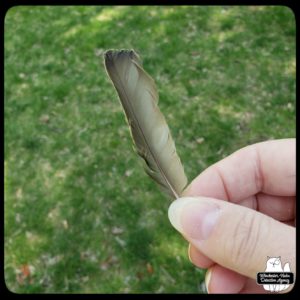
“Their feathers are hard to come by as are their bones. Those are ingredients used by witches for clients who need help with pregnancies.”
“What kind of help?” I asked. “Like in order to get pregnant?”
Gus continued, “It could be. There are a variety of ways to use them. To get pregnant. To cause someone to miscarry. To find suitable adoptive parents. It depends.”
“Damn. That’s interesting,” I said. “They’re all over the United States and a lot of Central America and Canada. They used to stay close to livestock, but as more land was deforested, they began coming to bird feeders. That makes them more easy to target by familiars.”
“Are you implying something?” Gus squinted and lowered a brow at me.
“No. I know you’re just practicing your skills. But I have noticed that the cowbirds stay away from you,” I said. I’ve also been faced with forced-birth protesters every week when I go to work in town. They stand in front of the health clinic with their signs. They might pretend witchcraft is about a devil, but it would not surprise me if they’re willing to cast their own spells, which they call prayers, to force people to birth children and give them up for adoption. There are plenty of rituals that are the same as spellcasting only called by other names.
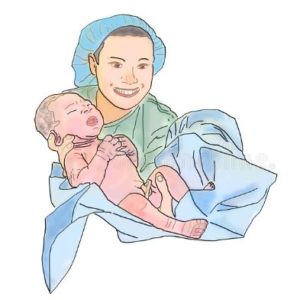
Case Findings:
Brown-headed cowbirds are directly affected by the deforestation. This region is going through a lot of that with more and more housing developments and unneeded shopping centers when plenty remain abandoned. If the wrong people begin to realize how magickal the cowbirds are, they may start using their parts for rituals to force pregnancies or to force miscarriages on people they hate instead of minding their own business.
Case Status: Closed
Resources:
Survival by Degrees at Audubon
